 |
 |
|
 |
2006 legislative session begins March 1 |
 |
 |
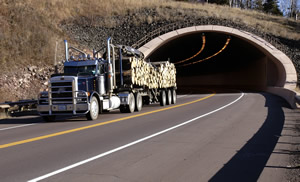 |
|
This session Mn/DOT will ask the Legislature to increase the allowable weight on trucks to address inconsistencies between Minnesota and its border states as well as the inequities across industries. This photograph shows a six-axle logging truck on Hwy 61 north of Two Harbors. Photo by David Gonzalez |
The 2006 legislative session officially kicked off March 1, although much work during the past several months already has gone into preparing for it.
In even-number years, the Legislature focuses on capital budgets, which fund projects such as land acquisition and the construction and repair of state agency buildings, facilities, parks and trails. Capital budgets also provide for grants to local governments to repair and construct schools, parks and bridges.
The governor’s capital bonding proposal, announced in January, requests $897 million in bonding. Of this amount, more than $140 million would go to transportation-related capital projects. See Mn/DOT Newsline (Jan. 18, 2006) for more details.
Several other topics will get legislative attention, too, said Betsy Parker, Government Affairs director. Those related to transportation include:
Truck weight increase—Mn/DOT will ask legislators to change truck weight laws to address the inconsistencies between Minnesota and its border states as well as the inequities across industries that have resulted in added cost and reduced compliance.
Eminent domain—State law authorizes the commissioner of transportation to acquire by purchase, gift or eminent domain (condemnation) all land necessary to construct and maintain the state highway system. In 2005, the U.S. Supreme Court ruled that eminent domain could be used for economic development purposes. Mn/DOT uses eminent domain only for transportation projects, not for economic development. Some legislators are proposing that additional burdens be placed on government, such as having them pay attorney fees for land owners going through eminent domain proceedings.
Constitutional amendment—Voters in the 2006 general election will decide whether the state constitution should be amended so that 100 percent of the revenue generated from the Motor Vehicle Sales Tax is dedicated to highways and transit. Approximately 54 percent of MVST revenues currently are distributed by statute to transportation. The Legislature is expected to work on the wording of the amendment during this session.
Highway funding—The administration is asking the Legislature to authorize $2.5 billion in bonding to accelerate dozens of major highway projects across the state. This proposal is contingent on the passage of the MVST constitutional amendment in the fall; the new MVST revenues would be used to pay the debt service on the bonds over 30 years.
Related links:
|
back

|
 |
Building the interstate: I-94 transforms central Minnesota |
 |
 |
The following is one in a series of articles looking at the interstate highway system’s first 50 years—remembering the people, projects and cultural forces that shaped the creation of the nation’s largest public works project and the role Mn/DOT played in it.
The completion of Interstate 94 changed the landscape and the communities of central Minnesota inalterably.
Cities along the 260-mile route from Moorhead to the Twin Cities were connected as never before, and the freeway transformed the St. Cloud area into a major regional economic and cultural center.
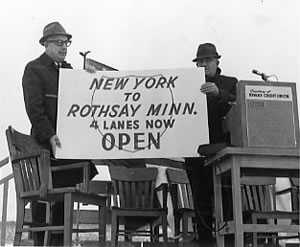 |
Scores of dedication ceremonies marked Interstate 94’s march across Minnesota. In 1968, area officials led a celebration at Rothsay marking completion of a section of I-94 in Otter Tail County. Mn/DOT photo archive |
I-94 also created a fast, direct route to the Twin Cities metro area for travelers from central Minnesota where they could capitalize on its employment, educational, cultural and recreational opportunities.
Suburban development boomed in the I-94 corridor between St. Cloud and the Twin Cities, accelerating development and altering the area’s political and physical geography as small cities such as Big Lake, St. Michael and Elk River gained population and economic clout.
The freeway bridge between Moorhead and Fargo was the first I-94 project completed. The first highway sections of I-94 west of St. Cloud were finished during the early to mid-1960s. Sections of the freeway in the Twin Cities were first opened to traffic in 1964: a one-mile segment in Minneapolis from Riverside Avenue to the East River Road and a 2.5-mile segment between Snelling Avenue and Marion Street in St. Paul.
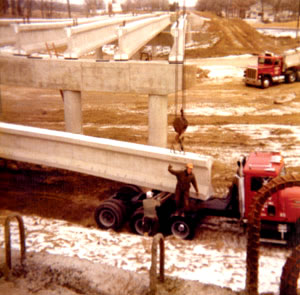 |
A construction crew prepares to place beams for a bridge over I-94 near St. Joseph in Stearns County during construction of the freeway in 1976. Photo by Mickey Klasen |
The final 11-mile section was completed in 1987 between Hwy 120 and Lakeland east of St. Paul. The last section also included construction of the St. Croix Travel Information Center and the state’s first automated weigh-in-motion truck scale.
The freeway’s route is a historic one in terms of Minnesota’s development. During the 1840s, traders started hauling goods overland from St. Paul going to Pembina in what is now North Dakota. The traders sold their goods to settlers or bartered them for animal pelts to supply the growing market for coats, hats and blankets made from fur.
The early traders, using high-wheeled, wooden carts pulled by oxen, created one trail from St. Paul that crossed central Minnesota, then followed the Red River of the North into North Dakota and Canada. Known as the Middle Trail, the route followed by the oxcart trains created the path for railroads, state and county highways and ultimately I-94.
To read more about the development of I-94 and other Minnesota segments of the interstate, visit Mn/DOT’s Web site at www.dot.state.mn.us/interstate50/.
By Craig Wilkins
Working on I-94 pivotal to Tony Kempenich’s Mn/DOT career
Like many other Mn/DOT employees, Baxter's Tony Kempenich began his Mn/DOT career working on I-94. The Little Falls native started on the project in the summer of 1976 while attending what is now the St. Cloud Area Vocational and Technical College.
Now District 3's materials engineer, Kempenich credits his work on the freeway as a major building block of his career.
"We learned a lot back then—working with contractors, dodging bulldozers and doing things by the seat of our pants," he said.
|
|
back

|
 |
Minnesota, Wisconsin DOT leaders explore shared issues |
 |
 |
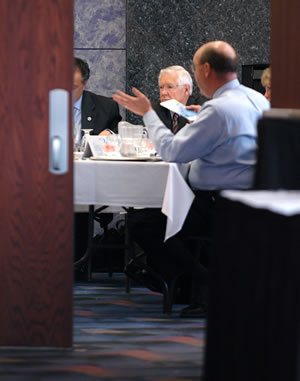 |
|
Bob Winter, director of District Operations, and Deputy Commissioner Doug Differt joined the discussion held with leaders from Mn/DOT and the Wisconsin DOT. Photo by David Gonzalez |
Leaders from Mn/DOT and the Wisconsin DOT explored several issues including maintenance operations when they met Feb. 15 in Woodbury.
The discussion was wide-ranging and included topics such as the effects of transportation on economic development and vitality, funding issues and highway maintenance practices, said Bob Winter, District Operations Division director.
Mn/DOT participants included members of the commissioner’s staff, division directors and district engineers.
The meeting was similar in format to one held last year when Mn/DOT managers met with their counterparts from the Iowa DOT.
WisDOT officials reported on their department’s recent reorganization; it now operates with five regions instead of its former eight-district structure.
The officials also discussed the future financial effects of the Wisconsin Legislature’s recent decision to repeal a state law that indexed the state’s gas tax to the price of fuel.
Winter said highway maintenance managers from the two DOTs will meet again to explore issues such as snow and ice control management and technology.
“We are organized quite differently,” Winter said, “but we have many of the same issues.”
By Craig Wilkins
|
back

|
 |
New program seeks trash haulers to join volunteer litter removal effort |
 |
 |
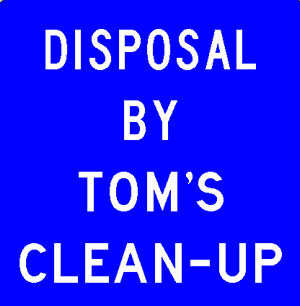 |
|
Participating firms will be recognized with highway signs in the areas they serve. The two-foot square signs will be mounted on existing Adopt-A-Highway sign posts.
|
Mn/DOT will expand the concept of its Adopt-A-Highway program to a new set of participants—trash haulers.
The new program allows commercial trash haulers to “adopt” one or more truck stations by disposing of roadside litter stored in their trash bins without cost.
Jan Ekern, partnerships coordinator, Office of Maintenance, said the idea for the program started last year when a trash hauler in the Rochester area proposed disposing of roadside litter for free in exchange for signs noting its service donation.
She said the program was approved after a policy review. Mn/DOT launched the program on Feb. 23.
Ekern estimates the program could save as much as $250,000 per year in “tipping fees”—charges levied for using landfills.
Haulers, she said, would collect only bagged roadside litter picked up by Adopt-A-Highway volunteers, Sentencing to Service crews and department maintenance employees.
They would not collect Mn/DOT-generated wastes such as trash, tires, paint, oil or other materials. Mn/DOT would continue to dispose of materials that are recyclable, deemed hazardous or unsuitable for landfill disposal, she said.
The haulers would place dumpsters at each truck station reserved exclusively for storing roadside litter. Other pickup arrangements are possible, depending on the needs of the hauler and the truck station.
Mn/DOT will promote participation in the program via trash hauler associations and other trade organizations, Ekern said
Once a trash hauler is assigned to one or more truck stations, signs bearing the company’s name will be added to existing Adopt-A-Highway signposts in the area.
“We have a successful model in the Adopt-A-Highway program which has thousands of volunteer groups committed to removing litter from the state’s highways,” Ekern said. “We hope this program will complement the highway groups by increasing civic involvement and allowing us to cut costs for litter collection and disposal.”
Related information:
By Craig Wilkins
|
back

|
 |
|
 |



